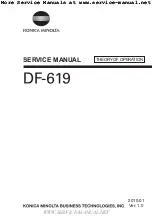
Centre Section
Introduction
The console’s centre section (see opposite) – although not strictly in the centre of the console – comprises four
main areas:
Centre section meter panel.
Analogue master control functions.
TFT screen and associated control panel dedicated to DAW control.
In the fader area, a dual purpose panel provides further DAW-associated functions and motion controls,
while on the right of this panel are located controls for the main bus outputs, including an assignable
master fader, plus a set of talkback buttons.
The following pages cover all the analogue controls in the centre section. See Section 5 for details of the
console’s DAW control facilities.
Power Supply Indicators
Starting in the top left of the main area of the centre section, you will find a row of four LEDs that display the
current state of power rails within the console. The ±15 Volt and the +4 Volt supplies are for analogue audio and
logic circuitry respectively. The +12 Volt supply provides power for the faders and some relays. All LEDs should
normally be illuminated, if not – try not to panic!
The rest of the analogue facilities in the centre section will be discussed in a logical ‘audio’ order, starting with
the console’s main outputs.
Main Output Functions
Both the console’s stereo Record and Mix busses are provided with identical controls. To see these in
diagrammatic form, refer to the foldout diagram at the end of this manual.
A ‘mini-matrix’ of main bus select functions (see left), on the motion control panel, is used to assign facilities to either of
the busses:
Press and hold the required
RECORD
or
MIX
bus button.
Select the required facility; the associated ‘flag’ will light to confirm
your selection.
To all intents and purposes, the bus signal flows through these facilities
from top to bottom.
The Record and Mix busses have balanced pre fade insert points. Switching
on
INS
switches the insert point into circuit, with the insert return replacing
the bus signal. If
∑
is selected then the insert return is summed with the bus
signal. This opens up a number of creative options - for example you can
sum the output of another submixer or of your DAW with the console mix
busses without using channels or you can process some signals via the
Record bus, then sum the Record bus outputs with the Mix bus for further
processing.
This insert point for each bus is pre main fader and compressor (see below).The insert send and returns are
connected via 6.35mm jacks on the centre section connector panel (Send/Return, Left/Right).
Centre Section
AWS 900+ Owner’s Manual
4 - 1 5
1
2
2
3
1
4
1
2
Summary of Contents for AWS 900+
Page 4: ...Owner s Manual Solid State Logic 82S6AWS030A ...
Page 21: ...Installation and Setup 3 4 AWS 900 Owner s Manual ...
Page 40: ...This page is intentionally blank Signal Processor Routing AWS 900 Owner s Manual 4 13 ...
Page 41: ...Console Operator s Guide 4 14 AWS 1 2 3 4 ...
Page 87: ...MCU Control GuidE 5a 6 AWS 900 Owner s Manual Standard Mackie Control Front Panel Layout ...
Page 91: ...MCU Control GuidE 5a 10 AWS 900 Owner s Manual Mackie Control Surface Steinberg Overlay ...
Page 95: ...MCU Control GuidE 5a 14 AWS 900 Owner s Manual Mackie Control Surface Sonar Overlay ...
Page 107: ...Total Recall 6 8 AWS 900 Owner s Manual ...
Page 123: ...AWSomation 7 16 AWS 900 Owner s Manual ...
Page 130: ...A blank page AWS 900 Owner s Manual A 7 MIDI Implementation Chart ...
















































